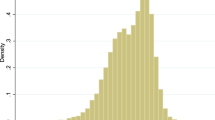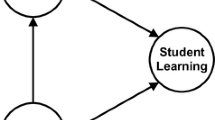Abstract
Past research on socioeconomic status (SES) and test performance in higher education has highlighted the factors that depress performance among students from low-SES backgrounds. We complement this work by focusing on how cues of affluence and prestige in the physical environments of elite universities may boost performance among students from high-SES backgrounds, thereby exacerbating the existing performance gap between high and low-SES students. We randomly assigned 122 high-SES and 100 low-SES students to take a standardized test in an environment with affluence cues or one without affluence cues. We found a significant interaction between student-SES and testing environment, such that students from high-SES backgrounds outperformed students from low-SES backgrounds to a greater extent when affluence cues were present than when they were absent. These findings suggest that the physical environments of elite universities can contribute to the achievement gap between high and low-SES students. Theoretical and educational policy implications are discussed.


Similar content being viewed by others
Notes
In addition to the affluence cues manipulation, we included a university identity prime manipulation by giving half of the participants t-shirts and pencils with the school’s logo, and the other half a plain t-shirt and pencil. Our goal was to assess if the effects of affluence cues would be moderated by whether students were reminded of their identity as members of the university. This identity salience manipulation did not have any effect on students’ test performance, F(1,214) = .02, p = .89, and also did not significantly interact with either students’ SES or the presence of affluence cues in the environment (all p’s greater than .4). Therefore, in this paper we report findings collapsed across the identity prime conditions.
References
Cheryan, S., Plaut, V. C., Davies, P. G., & Steele, C. M. (2009). Ambient belonging: How stereotypical cues impact gender participation in computer science. Journal of Personality and Social Psychology,97, 1045–1060.
Cohen, G. L., & Garcia, J. (2008). Identity, belonging, and achievement: A model, interventions, implications. Current Directions in Psychological Science,17, 365–369.
Croizet, J.-C., & Claire, T. (1998). Extending the concept of stereotype threat to social class: The intellectual underperformance of students from low socioeconomic backgrounds. Personality and Social Psychology Bulletin,24, 588–594. https://doi.org/10.1177/0146167298246003.
Faul, F., Erdfelder, E., Buchner, A., & Lang, A.-G. (2009). Statistical power analyses using G*Power 3.1: Tests for correlation and regression analyses. Behavior Research Methods,41, 1149–1160.
Gilbert, D. (2011). The American class structure in an age of growing inequality (8th ed.). Thousand Oaks, CA: Pine Forge Press.
Goudeau, S., & Croizet, J.-C. (2017). Hidden advantages and disadvantages of social class: How classroom settings reproduce social inequality by staging unfair comparison. Psychological Science,28, 162–170. https://doi.org/10.1037/xge0000014.
Granfield, R. (1991). Making it by faking it: Working-class students in an elite academic environment. Journal of Contemporary Ethnography,20, 331–351. https://doi.org/10.1177/089124191020003005.
Haveman, R., & Smeeding, T. (2006). The role of higher education in social mobility. The Future of Children,16, 125–150.
Jack, A. A. (2019). The privileged poor: How elite colleges are failing disadvantaged students. Cambridge, MA: Harvard University Press.
Johnson, S. E., Richeson, J. A., & Finkel, E. J. (2011). Middle class and marginal? Socioeconomic status, stigma, and self- regulation at an elite university. Journal of Personality and Social Psychology,100, 838–852.
Kraus, M. W., Piff, P. K., & Keltner, D. (2009). Social class, sense of control, and social explanation. Journal of Personality and Social Psychology,97, 992–1004. https://doi.org/10.1037/a0016357.
Kusserow, A. (2012). When hard and soft clash: Class-based individualisms in Manhattan and Queens. In S. T. Fiske & H. R. Markus (Eds.), Facing social class: How societal rank influences interaction (pp. 195–215). New York, NY: Russell Sage Foundation.
Latu, I. M., Mast, M. S., Lammers, J., & Bombari, D. (2013). Successful female leaders empower women’s behavior in leadership tasks. Journal of Experimental Social Psychology,49, 444–448. https://doi.org/10.1016/j.jesp.2013.01.003.
Markus, H. R., & Stephens, N. M. (2017). Editorial overview: inequality and social class: The psychological and behavioral consequences of inequality and social class: a theoretical integration. Current Opinion in Psychology,18, 4–12.
Medina, J. (2019). What’s life like as a student at U.S.C.? Depends on the size of the bank account. The New York Times. Retrieved from https://www.nytimes.com/2019/04/03/us/usc-admissions-scandal-students.html. Accessed 25 Sept 2019.
Mendoza-Denton, R., Shaw-Taylor, L., Chen, S., & Chang, E. (2009). Ironic effects of explicit gender prejudice on women’s test performance. Journal of Experimental Social Psychology,45, 275–278. https://doi.org/10.1016/j.jesp.2008.08.017.
Ostrove, J. M. (2003). Belonging and wanting: Meanings of social class background for women’s constructions of their college experiences. Journal of Social Issues,59, 771–784. https://doi.org/10.1046/j.0022-4537.2003.00089.x.
Ostrove, J. M., & Long, S. M. (2007). Social class and belonging: implications for college adjustment. Review of Higher Education,30, 363–389.
Pascarella, E. T., Pierson, C. T., Wolniak, G. C., & Terenzini, P. T. (2004). First-generation college students: Additional evidence on college experiences and outcomes. Journal of Higher Education,75, 249–284.
Shih, M., Pittinsky, T. L., & Ambady, N. (1999). Stereotype susceptibility: Identity salience and shifts in quantitative performance. Psychological Science,10, 80–83. https://doi.org/10.1111/1467-9280.00111.
Steele, C. M., & Aronson, J. (1995). Stereotype threat and the intellectual test performance of African Americans. Journal of Personality and Social Psychology,69, 797–811. https://doi.org/10.1037/0022-3514.69.5.797.
Stephens, N. M., Brannon, T. N., Markus, H. R., & Nelson, J. E. (2015). Feeling at home in college: Fortifying school-relevant selves to reduce social class disparities in higher education. Social Issues and Policy Review,9, 1–24. https://doi.org/10.1111/sipr.12008.
Stephens, N. M., Markus, H. R., & Phillips, L. T. (2014). Social class culture cycles: How three gateway contexts shape selves and fuel inequality. Annual Review of Psychology,65, 611–634.
Walton, G. M., & Cohen, G. L. (2011). A brief social-belonging intervention improves academic and health outcomes among minority students. Science,331, 1447–1451.
Warburton, E. C., Bugarin, R., & Nuñez, A. (2001). Bridging the gap: Academic preparation and postsecondary success of first-generation students (NCES 2001‐153). Washington, DC: National Center for Education Statistics, U.S. Government Printing Office.
Wiederkehr, V., Darnon, C., Chazal, S., Guimond, S., & Martinot, D. (2015). From social class to self-efficacy: Internalization of low social status pupils’ school performance. Social Psychology of Education,18, 769–784. https://doi.org/10.1007/s11218-015-9308-8.
Wilson, J. L., Meyer, K. A., & McNeal, L. (2012). Mission and diversity statements: What they do and do not say. Innovative Higher Education,37, 125–139.
Acknowledgements
This research was funded by a Research Initiative on Diversity & Equity (RIDE) Award from the University of California, Los Angeles, to H.W. Ni, B.M. Goodale, P.A. Goff & Y.J. Huo, as well as National Science Foundation Graduate Research Fellowships awarded to H.W. Ni and B.M. Goodale.
Author information
Authors and Affiliations
Corresponding author
Ethics declarations
Conflict of interest
The authors declare that they have no conflicts of interest with respect to their authorship or the publication of this article.
Statement on ethical approval and informed consent
All procedures performed in this study were approved by the institutional review board of the researchers’ and participants’ university. All procedures are in accordance with the ethical standards of the institutional research committee. In addition, informed consent was obtained from all individual participants included in the study.
Additional information
Publisher's Note
Springer Nature remains neutral with regard to jurisdictional claims in published maps and institutional affiliations.
Appendix
Appendix
1.1 Examples of objects in the affluent and control testing environments

1.2 Social class levels question
Socioeconomic status (SES) refers to the combination of education, income, and job an individual possesses. A teacher with a Masters Degree in Education who earns $40,000 a year may consider herself a median SES; although she does not earn much, her professional degree places her in a higher SES bracket. Please indicate where you believe your family to fall compared to other Americans:
Very high SES: Top-level executives, multi-millionaires, celebrities, and national politicians; individuals often have an Ivy League education and professional degrees. Annual household incomes of $150,000–$500,000 and above.
High SES: Highly-educated individuals, often with graduate or professional degrees, corporate elite and/or middle management with large work autonomy and economic security. Annual household incomes of $75,000–$150,000.
Median SES: College-educated workers, white-collared semi-professionals and/or craftsmen with some work autonomy. Annual household incomes of $35,000–$75,000.
Low SES: Blue collar workers or individuals with low job security; may have completed high school education. Annual household incomes of $16,000–$35,000.
Very low SES: Individuals typically living below poverty line with little to no participation in the work force and may have some high school education.
Rights and permissions
About this article
Cite this article
Ni, H.W., Goodale, B.M. & Huo, Y.J. How the rich get richer: affluence cues at universities increase the social class achievement gap. Soc Psychol Educ 23, 125–141 (2020). https://doi.org/10.1007/s11218-019-09528-z
Received:
Accepted:
Published:
Issue Date:
DOI: https://doi.org/10.1007/s11218-019-09528-z




